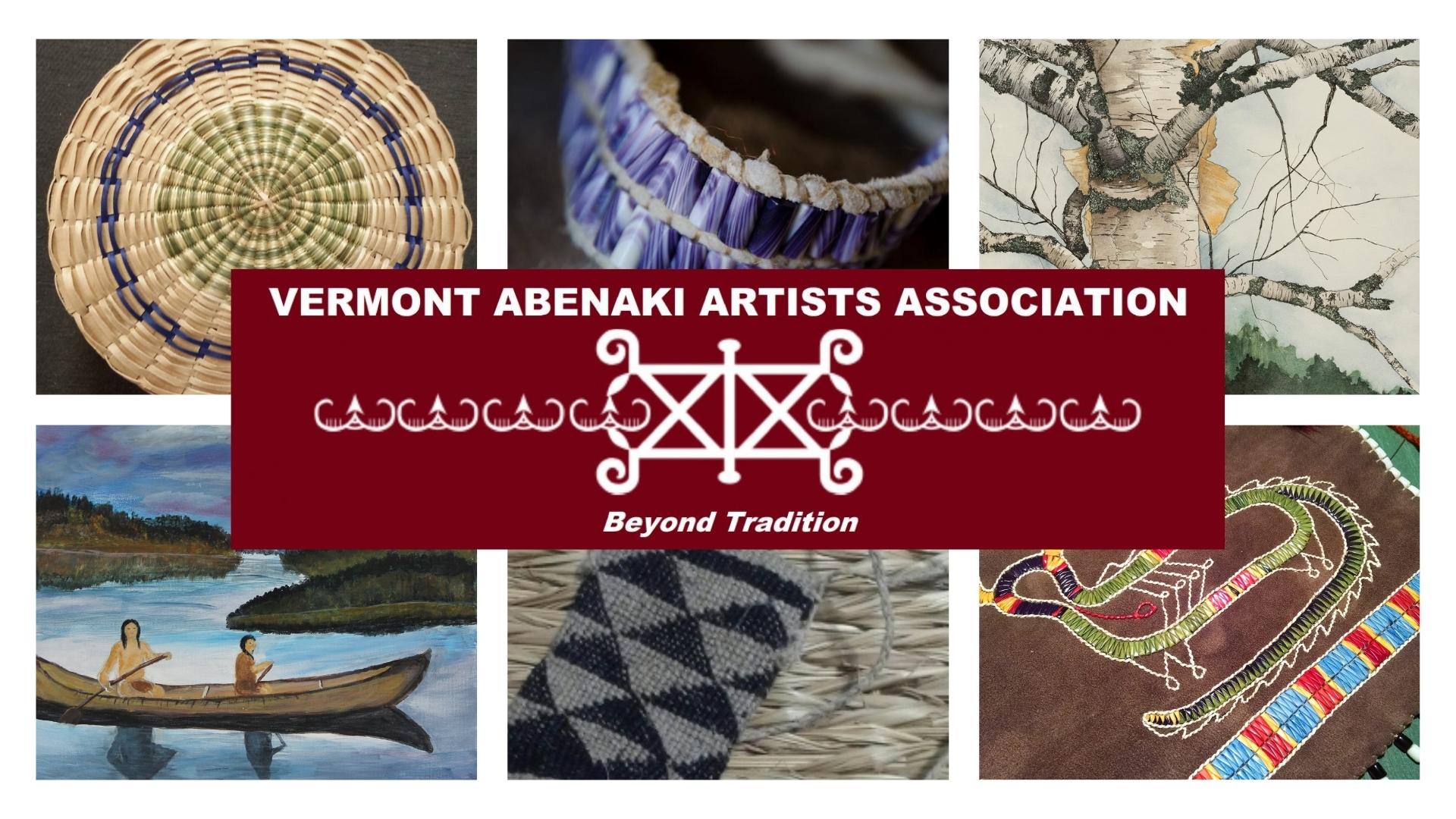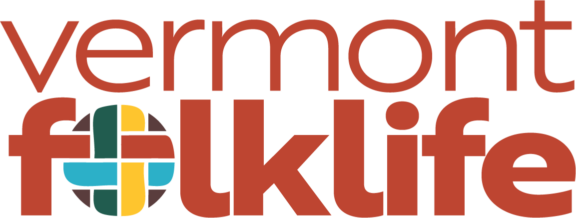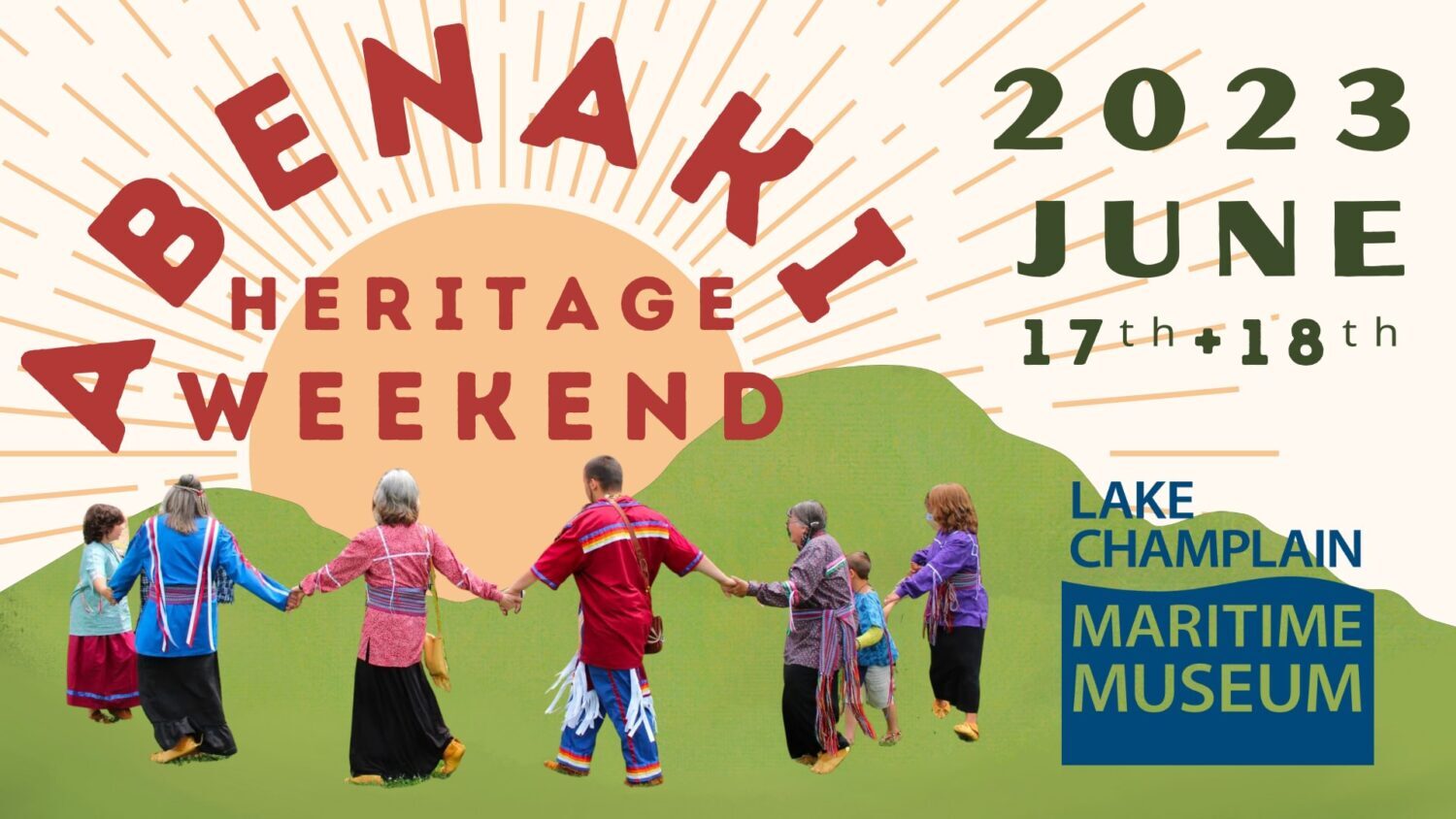Sherry Gould (Nulhegan Band of the Coosuk Abenaki Nation) and Vera Sheehan (Elnu Abenaki Tribe), are both lifelong artists and their apprenticeship structure is unique. They are both recognized in their communities as expert artists in different art forms. Sherry is a basket maker. In 2006 she became a juried basketmaker through the League of New Hampshire Craftsmen in 2006, being the first Native American artist in the league. Sherry and her husband, Bill, work to maintain basketmaking as part of Abenaki culture through teaching other Abenaki people through traditional arts programs in New Hampshire and Vermont. Sherry is also a state representative in New Hampshire. Vera practices knotting: Abenaki textile weaving using natural fibers such as milkweed (also referred to as twining). She is also an educator and activist, the Director of the Vermont Abenaki Artists Association, and the Founder of the Abenaki Arts & Education Center, and previously a Museum Educator and the Smithsonian National Museum of the American Indian.
Click here to read the full article on the Vermont Folklife website and listen to recordings by Sherry and VeraBasketmaking
Abenaki Heritage Weekend 2023
June 17-18 at Lake Champlain Maritime Museum
On June 17-18, 2023, citizens of the New England Abenaki community will gather at Lake Champlain Maritime Museum to celebrate their history and heritage, and the public is invited! Organized by the Vermont Abenaki Artists Association, this free event is open from 11 a.m. to 4 p.m. both Saturday and Sunday.
One of the highlights is the Native Arts Marketplace of the Vermont Abenaki Artists Association, where visitors can talk to artists, watch craft demonstrations, and purchase outstanding beadwork, paintings, jewelry, wampum, woodwork, leatherwork, drums, and other items.
“The variety and quality of the work created by our Abenaki artists is outstanding,” said Vera Longtoe Sheehan, Executive Director of the Vermont Abenaki Artists Association. “Some of our artists create traditional art and some create contemporary art, often inspired by tradition. If you are looking to purchase a special gift or something new for your collection, be sure to visit the Native Arts Marketplace.”
Throughout the weekend there will be activities of interest to everyone. Bring a picnic lunch and enjoy singing and drumming by the Nulhegan Drum — you may even be invited to drum with them. Children and adults alike should not miss storytelling by Abenaki author and historian Joseph Bruchac, and songs for the little ones with Francine Poitras Jones.
Artists in the Arts Marketplace include Michael Descoteaux demonstrating the making of hand drums; Elnu Abenaki Elder Jim Taylor making wampum beads from whelk and quahog shells; and Linda Longtoe Sheehan weaving wampum, an intricate process using the shell beads. On Saturday, meet basketmaker Kerry Wood. On Sunday, visit the “Make and Take” table, where children can make a gift to bring home for Father’s Day.
A new special exhibit, Beyond the Curve: The American Abenaki Covid Experience will open during Heritage Weekend in the Schoolhouse Gallery, and will be on view all season. Artwork and stories by 20 American Abenaki artists illustrate the impact of the pandemic in the Abenaki homeland and the resilience of Abenaki people during troubled times. Meet the curator, Vera Longtoe Sheehan, for a gallery talk.
Thanks to Vermont Humanities, Vermont Arts Council, and Vermont Department of Health for their sponsorship of the event. For more information on Abenaki Heritage Weekend, visit: AbenakiArt.org/abenaki-heritage-weekend.
# # #
Late Period (1890-1970) Indian Baskets In Vermont, PDF Series
by Frederick Mathew Wiseman, Ph.D.
Publication from the the Indigenous Vermont Series 2012:9, published courtesy of Wôbanakik Heritage Center.
EXCERPT FROM INTRODUCTION
“The prime directive of Haven is to reclaim lost, fragmented or otherwise damaged cultural practice and belief from Indigenous Vermont, and to a certain extent, applicable forms of documentation from neighboring areas. A second important principle is the repair of fragmented or damaged cultural practice by using all available reconstructive/healing tools. The third function of Haven is to make the repaired information available to those Indigenous Vermonters and their neighbors, who have any interest in reviving lapsed culture. The fourth reason; and the one that gives Haven its name, is to safely archive this information in a format that will be of use to future Indigenous generations, if the current one is uninterested.
Probably the one craft that is universally recognized as giving Indian Identity is the ash splint basket. Although probably not made before the 18th century, Indigenous Vermonters, as well as other regional tribes became masters of the craft. Much of the early history of Indigenous Vermont Baskets are to be found in other Haven publications.”
Late Period (1870-1970) Indian Baskets In Vermont – Part 1. 11 pages.
- Introduction
- Part1: Basket History and Technology & Preparing the materials for the Fancy Basket
Late Period (1870-1970) Indian Baskets In Vermont – Part 1A. 11 pages.
- Decorative overweave, or “Cowiss”
- Basket Handles and Hinges
Late Period (1870-1970) Indian Baskets In Vermont. Part 2. 11 pages.
- Part Two: Baket Types Represented in Vermont
- Multi-purpose work and arm baskets
Late Period (1870-1970) Indian Baskets In Vermont. Part 2A. 13 pages
- Knitting and Tatting baskets
- Baskets for the Hall Table
- Baskets for the Dining Room
- An unclassified basket
- Hampers. goose down baskets and other large, “fancy” baskets
- Basket for the Field and Lake
- Bibliography
Back to THE HISTORIC INDIGENOUS ARTS OF VERMONT and NEW HAMPSHIRE
Kerry R. Wood
Enrolled Citizen of the Nulhegan Band of the Coosuk Abenaki Nation
Juried Artist since 2016

Kerry Wood/Kalli Abazi is a citizen of the Nulhegan Band of the Coosuk Abenaki Nation. In 2016 she completed a 3 year apprenticeship program with Jeanne Brink through the Vermont Folklife Center Traditional Arts Apprenticeship Program for making traditional Black Ash and Sweetgrass baskets.
Elvine Obomsawin, Kerry’s Great-Grandmother, and her family made and sold baskets to tourists in Vermont in the early to mid-1900’s. Jeanne Brink is also Kerry’s cousin, and hearing the stories from their Obomsawin family heritage while learning basket making brought her past alive! When she is making baskets, she feels a deep connection with those who have gone before her, and is at peace and connected. Her husband helps prepare the ash by harvesting the ash trees and, with their son Aaron, pounds and splits the ash. The family works together to create the materials for baskets from the harvest of the tree to the final project.
Kerry has baskets on display at the Vermont Maritime Museum, The Abenaki display at the Burlington Airport, and at the Bennington Museum. Black Ash and baskets remain a critical aspect of Abenaki culture and heritage. They are part of Ndakinna, our land. Kerry teaches Abenaki people and others the history and craft of Abaznodaka as well as the language of the Abenaki people, Alnôbaôdwa, so the culture and heritage will continue. She is also collaborating with people across Vermont to help combat the impact of the Emerald Ash Borer, which threatens the very existence of the Black Ash trees. Basket making is part of the Abenaki soul and heritage, and it is critical to ensure it is never lost.
Contact
Email: [email protected]



Demonstrations (as an Apprentice with Master Basketmaker Jeanne Brink)
2016
- Dartmouth Powwow, Dartmouth College
- Native American Program, Dartmouth College
- Vermont History Exposition, Tunbridge, VT
2015
- Abenaki History Day, Hartford, VT
- Dartmouth Powwow, Dartmouth College, NH
- Native American Program, Dartmouth College, NH
- Saratoga Native American Festival, Saratoga, NY
2014
- Dartmouth Powwow, Dartmouth College, NH
- Native American Program, Dartmouth College, NH
- Vermont History Exposition, Tunbridge, VT
Awards
2013, 2014, 2015
- Traditional Arts Apprenticeship Program, Vermont Folk Life Center. Middlebury, VT
Affiliations
- Vermont Abenaki Artists Association
John Hunt
Enrolled Citizen of the Nulhegan Band of the Coosuk Abenaki Nation
Juried Artist since 2016

John Hunt grew up in the farm country of Vermont. When he was young, his father would tell him about his native heritage and about how their ancestors had lived. John enjoyed imaging how it was long, long ago as well as how his grandfathers lived more recently. He saw how life used to be made up of your own two hands. Whether it was tools needed for farming or hunting or things you would need around the house like bowls and baskets it all had to be made by someone’s skilled hands.
This inspired John to have a relationship to life like his family had always had. To know how to make what he needed from the land around him. When he looked back at many of the tools of our ancestors, he saw they were created not only to be functional but beautiful as well. He was inspired by that way of being and has chosen to live his life in that way. Though he has tried and practiced many art forms, he has focused most on carving, basketry, and pyrography.
ARTIST STATEMENT
I have been creating art since I was a child, but since the age of 18, it has become a very strong focus in my life. Though I have never had one primary teacher, I have learned through many people over the years as well as through my own personal practice.
Carving: For my carving, I use many types of wood. For kitchen utensils, I like to use a hardwood like black walnut,

black cherry, apple, maple, etc. and for more figure/ sculpture carving I use soft woods like white pine or cedar.
Basketmaking: My family members were basket makers that sold their wares around northern VT. However, there is no longer anyone in my direct family practicing this art, so I have sought out many different teachers over the years. Though I haven’t formally studied with anyone, I have spent time with many different basket makers around Vermont. I primarily make bark and willow baskets. For the willow, I gather from a few locations by my home that grows nice long rods, and I tend these patches. For my bark baskets, I prefer pine, and I keep my eye out for trees that have fallen over during the winter and peel their bark in the spring.
To create my art, I use modern hand tools. However, I gather all of my materials from the natural world. My art is an expressive outlet for me and a connection to my ancestors. I really enjoy making things that have a function as a spoon but going beyond function and giving it a unique beauty. I find inspiration for my crafts in nature around me. I try to have my crafts showcase and lead to the innate majesty of the plants, animals, and elements.
Pyrography: Over the last several years, I have studied traditional Wabanaki designs and the images I see in nature. From these studies, I create my designs. I grow the gourds that I use and gather soft woods for my pyrography.



Contact Info
Email: [email protected]
MUSEUMS AND EXHIBITS
Currently
Part of the permanent collection of Abenaki Cultural items at the Burlington International Airport, Vermont.
2017
Alnobak: Wearing Our Heritage. Traveling Exhibit. Lake Champlain Maritime Museum
AFFILIATIONS
Vermont Abenaki Artists Association
Bill Gould
Enrolled Citizen of the Nulhegan Band of the Coosuk Abenaki Nation
Juried Artist since 2014

Bill Gould lives in Warner, NH with his wife Sherry. They were both born and raised in New Hampshire. Together they raised their two daughters in Warner. Bill is a lumberman by trade. They celebrate their Abenaki heritage and love making beautiful baskets.
Together Sherry and Bill studied utilitarian Abenaki basket-making in 2006 under master artist Newt Washburn of Bethlehem, NH. Bill has taught Steve Lewko Abenaki utility basket making for two years through an award from the NH Arts Council, Traditional Arts program.
In 2011 Bill, together with Jesse Lacquer started the NH/VT Abenaki Basketmakers Alliance. Bill and his wife, Sherry, work to maintain basketmaking as part of Abenaki culture through teaching other Abenaki through the traditional arts programs in New Hampshire and Vermont.
Artist Statement
I like to make baskets. My life and livelihood revolves around wood. Basket making ties my love of wood to my Native American heritage. I got started back when my wife needed molds and tools to make her baskets. Eventually, I worked with Newt Washburn; I learned to identify brown ash trees, cut them, pound them and prepare the wood into strips for splints and weavers or handles or rims.
I love working with a crooked knife; it allows me to feel the wood. Newt taught me to try different methods and do what works best for me. I like a certain method of joining my swing handles; instead of using a small brass nail, I weave a tail of the wood through itself. I think that works good. It is especially rewarding for me to hold a finished basket in my hands, knowing that I have made good choices about using the right pieces of wood and preparing them with skill.
In my daily work, I harvest trees, saw them into boards, provide slabs for boiling sap to syrup, provide lumber to build things like houses or furniture, renovate my home and heat my house with it. Basket making requires no modern technology to create something visually pleasing that is as functional today as it was 200 years ago. I want to do my part to preserve this timeless culture. When people see my basket, I’d like them to see its art form and to see themselves using it.
Contact Info
Note: The Goulds do not have a store; however, they will accept custom orders.
Email: [email protected]




Demonstrations
2013
- Discovering Your Native American Roots, Franklin Pierce Homestead, Hillsboro, NH
- Mt. Kearsarge Indian Museum, Harvest Moon Festival, Warner, NH
- Lee Farm Fiber Festival
2012
- Nulheganaki. Island Pond, VT
- Mt. Kearsarge Indian Museum, Harvest Moon Festival, Warner, NH
2011
- “New Hampshire Open Doors”
- Harvest Moon Festival, Mt. Kearsarge Indian Museum, Warner, NH
- Town of Holderness 250th Celebration, Holderness, NH
- The Hillsboro Historical Society., Hilsboro, NH
- Franklin Pierce Homestead, ,NH
2010
Cornish Fair, Cornish, NH
2009
League Of NH Craftsmen Fair
2008
Saratoga Native American Festival, Saratoga, NY
Exhibits
2014
- “Traditional Sources, Contemporary Visions” – Invitational Group Art Exhibit
- Lake Champlain Maritime Museum, Vergennes, VT
2011
Basket Trail, Warner Historical Society, Warner, NH.
2010
- Baskets and Boxes, Gallery 205, LNHC, Concord, NH
- New England-Based Indigenous Artists, Diamond Library, UNH, Durham, NH
- Walking with Us – Honoring the Northeast Native American Heritage, Mill Brook
Gallery & Sculpture Garden, Concord, NH.
2009
- Tomorrow’s Masters, Hopkinton Historical Society, Hopkinton, NH
- First People of the Northeast, Mill Brook Gallery & Sculpture Garden, Concord, NH
2007
Gallery 205, League of New Hampshire Craftsman (LNHC), Concord, NH.
Consultations
- “Abenaki Basket Trail” Organizing consultant, sponsored by Mt. Kearsarge Indian Museum, Hopkinton Historical Society, Newbury Historical Society, Warner Historical Society, New Hampshire Historical Society (2009-2011)
- “Hillsboro, NH Living History Event” Implementing a Native American component to this annual event. For 2011 funding from the NH Council on the Arts paid three Native American artists to present. For 2012 historic presentation of an early 19th century Abenaki basket maker tourist camp with sales will be integrated to the program on Jones Road. (2010 – present)
- “Holderness 250th Anniversary” Arranged Native American artisians to demonstrate beadwork, basketmaking and flute making. Also a woods walk, “The Feast at our Feet” (2011)
- Featured Articles
- Aug 2009, Notice of 76th annual Craftsmen’s Fair, Bradford artist demonstrators [online]. Bradford, NH: http://bradfordbridge.com, The Bradford Bridge. Available from World Wide Web: (http://bradfordbridge.com/2009/2009b_August_bradford_bridge.pdf)
- 2010. “timothy liles: new england collection at new york design week 2010” [online]. Design Boom. Available from the World Wide Web: (http://www.designboom.com/weblog/cat/8/view/10211/timothy-liles-new-england-collection-at-new-york-design-week-2010.html)
- Josh Trott, “Bill Gould, Basket making, and the Emerald Ash Borer,” Writing of Indigenous New England, accessed February 13, 2014, http://indnewengland.omeka.net/items/show/115.
Awards
- Traditional Arts Apprenticeship grant NH Council on the Arts, Steve Lewko intern, Warner, NH, 2012
- Traditional Arts Apprenticeship grant NH Council on the Arts, Steve Lewko intern, Warner, NH, 2013
Affiliations
- NH/VT Abenaki Basketmakers Alliance
- League of New Hampshire Craftsman (2009-present)
- Northeast Basket Makers Guild (2010-present)
- Vermont Abenaki Artists Association


